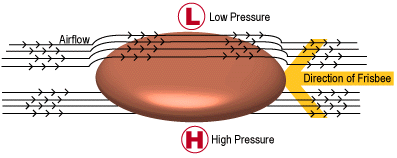Lift, Drag, and Rotation
When a Frisbee is thrown the disk glides through the air in a horizontal motion and spins around its axis. This occurs because of three concepts which are known in Physics as lift, drag, and rotation.
Lift:
 |
| ~http://www.exploratorium.edu/ |
Lift is the force
perpendicular to the direction of motion though air.
Lift is created when air flows faster over an object
than below. This occurs when the edge of an object is
curved allowing for the air to move quicker over the
top than the bottom. This is what allows a Frisbee to
glide longer distances than a flat object of the same
dimensions. Lift can be explained by the Bernoulli
principle. Bernoulli's principle states that when air
moves at a higher speed the air has a lower pressure
and when air moves at a lower speed air has a higher
pressure. Lift acts on the bottom edge of the disk and
not the center.
Drag:
In
the case of the Frisbee drag is the force
opposite of the direction of motion created by
air resisting the Frisbee. Unlike most objects
the Frisbee is disk shaped and somewhat flat.
Most of the Frisbee's surface is on the top
and bottom. Because of this the air resists
less of the Frisbee and results in less drag.
 |
| ~https://www.scientificamerican.com |
Rotation:
Rotation
is the force that keeps the Frisbee horizontal
during its flight. Because lift acts on the
bottom edge of the disk the disk would flip
without rotating. The reason the disk does not
flip while rotating is because of a scientific
principle called gyroscopic motion. At each
point in time the disk is wanting to flip at
the point that the lift is acting on it. As
the Frisbee spins the direction that the disk
wants to flip changes. This happens at every
point as the disk spins all the way around.
Because of this the disk is always
counteracting the lift from flipping the disk.
Drag also plays a part in the disk not
flipping. At each point in time during the
rotation the air is flowing over the top and
bottom of the disk keeping it from wobbling.